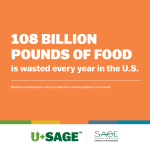The USDA has released a new image to support its Dietary Guidelines for Americans, the plate shown above. The iconic pyramid logo was introduced in 1992, but its reformulation in 2005 came with a lot of criticism. The new My Plate concept addresses some of those concerns with a more simplified program. The plate image is divided into four sections, in the ratio of amounts of each food you should eat. Fruits and vegetables should fill up half your plate, with grains and protein splitting the remaining half. Note that the largest portions are allocated to grains and vegetables. Dairy is left off to the side, represented by a circle, much like a drinking glass. There is no mention of the size your plate should be, which is important to note because as the plate gets bigger, so do the portions. The strength of this program is its visual nature. There is no need to measure serving sizes or weigh food, just fill up your plate in the right proportions. The new plate concept is definitely a step in the right direction, but it assumes a basic understanding of nutrition that many Americans simply do not have. Nutrition education remains a major challenge in this country. The plate idea has actually been in use as a teaching tool for people with diabetes, called The Idaho Plate Method. However, unlike My Plate, it was created to be used with educational materials under the guidance of a health professional. The USDA's plate does come with a short list of “selected messages,” like choosing low-fat over whole-fat dairy, but there is little else to direct consumers to specific choices. For example, it does not differentiate between fish and hot dogs as protein options. My guess would be it was designed for the majority of Americans who consider french fries a vegetable. While it falls short of what's really needed to promote healthy diets, if the My Plate concept manages to get some Americans to eat more fruits and vegetables, I'm all for it.








